 W
WAmleth is a figure in a medieval Scandinavian legend, the direct inspiration of the character of Prince Hamlet, the hero of William Shakespeare's tragedy Hamlet, Prince of Denmark.
 W
WHans Christian Andersen, in Denmark usually called H.C. Andersen, was a Danish author. Although a prolific writer of plays, travelogues, novels, and poems, he is best remembered for his fairy tales.
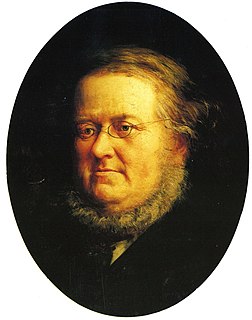 W
WPeter Christen Asbjørnsen was a Norwegian writer and scholar. He and Jørgen Engebretsen Moe were collectors of Norwegian folklore. They were so closely united in their lives' work that their folk tale collections are commonly mentioned only as "Asbjørnsen and Moe".
 W
WBjarmaland was a territory mentioned in Norse sagas since the Viking Age and in geographical accounts until the 16th century. The term is usually seen to have referred to the southern shores of the White Sea and the basin of the Northern Dvina River as well as, presumably, some of the surrounding areas. Today, those territories comprise a part of the Arkhangelsk Oblast of Russia, as well as the Kola Peninsula.
 W
W"Boots Who Made the Princess Say, 'That's a Story'" or "The Ash Lad Who Made the Princess Say, 'You're a Liar'" is a Norwegian fairy tale collected by Peter Christen Asbjørnsen and Jørgen Moe in Norske Folkeeventyr.
 W
WThe Boy Who Had an Eating Match with a Troll is a Norwegian fairy tale collected by Asbjørnsen and Moe. The troll is, as commonly depicted, not very intelligent and has poor vision, while the boy is clever, outwitting the troll to win an eating contest.
 W
WBushy Bride is a Norwegian fairy tale collected by Asbjørnsen and Moe. It is Aarne-Thompson type 403. It is included in Andrew Lang's Red Fairy Book.
 W
WA changeling, also historically referred to as an auf or oaf, is a human-like creature found in folklore and folk religion throughout Europe. A changeling was believed to be a fairy that had been left in place of a human stolen by the fairies.
 W
WThe church grim is a guardian spirit in English and Scandinavian folklore that oversees the welfare of a particular Christian church and protects the churchyard from those who would profane and commit sacrilege against it. It often appears as a black dog but is known to take the form of other animals.
 W
WCyprianus is a name given in Scandinavian traditions of folk magic to the "black book" ("Svarteboken"): a grimoire or manuscript collection of spells; and by extension to the magical tradition that these spells form a part of. There is no standard text called "Cyprianus"; it was a general label given to a collection of spells.
 W
WDapplegrim (Grimsborken) is a Norwegian fairy tale collected by Peter Christen Asbjørnsen and Jørgen Moe in their Norske Folkeeventyr. Andrew Lang included it in The Red Fairy Book.
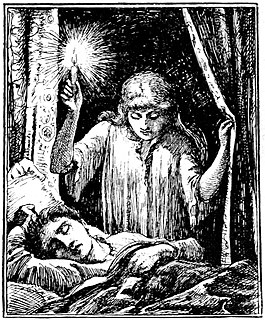 W
W"East of the Sun and West of the Moon" is a Norwegian fairy tale.
 W
WIn European folklore and myth, the Erlking is a sinister elf who lingers in the woods. He stalks children who stay in the woods for too long, and kills them by a single touch.
 W
WA fairy ring, also known as fairy circle, elf circle, elf ring or pixie ring, is a naturally occurring ring or arc of mushrooms. They are found mainly in forested areas, but also appear in grasslands or rangelands. Fairy rings are detectable by sporocarps in rings or arcs, as well as by a necrotic zone, or a ring of dark green grass. Fungus mycelium is present in the ring or arc underneath. The rings may grow to over 10 metres (33 ft) in diameter, and they become stable over time as the fungus grows and seeks food underground.
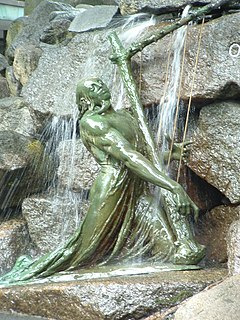 W
WFossegrim, also known simply as the grim (Norwegian) or Strömkarlen (Swedish), is a water spirit or troll in Scandinavian folklore. Fossegrim plays the fiddle, especially the Hardanger fiddle. Fossegrim has been associated with a mill spirit (kvernknurr) and is related to the water spirit (neck) and is sometimes also called näcken in Sweden. It is associated with rivers and particularly with waterfalls and mill races.
 W
WGertrude's Bird (Gjertrudsfuglen) is a Norwegian fairy tale collected by Peter Christen Asbjørnsen and Jørgen Moe in their Norske Folkeeventyr. The adventure is part of Asbjørnsen and Moe's collection of Norwegian Folk Tales, which was first published in the period 1841-1844. Of a total of 22 known legends in Norway Gjertrudsfuglen is the most prevalent. The adventure should be known in 39 variants.
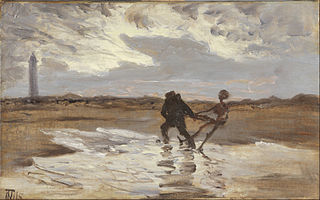 W
WA Gjenganger in Scandinavian folklore was a term for a revenant, the spirit or ghost of a deceased from the grave.
 W
W"'Good Day, Fellow!' 'Axe Handle!'" is a Scandinavian folktale, collected by Asbjørnsen and Moe.
 W
WGrödinge tapestry is a type of handwoven tapestry that is on display at the Swedish History Museum in Stockholm, Sweden. It originates from the Grödinge Church in the Diocese of Strängnäs at Botkyrka Municipality in Södermanland County, Sweden. The tapestry was donated to the Swedish History Museum in 1910.
 W
WHarpens kraft (Danish) or Harpans kraft, meaning "The Power of the Harp", is the title of a supernatural ballad type, attested in Danish, Swedish, Norwegian, and Icelandic variants.
 W
WA hulder is a seductive forest creature found in Scandinavian folklore. Her name derives from a root meaning "covered" or "secret". In Norwegian folklore, she is known as huldra. She is known as the skogsrå "forest spirit" or Tallemaja "pine tree Mary" in Swedish folklore, and ulda in Sámi folklore. Her name suggests that she is originally the same being as the völva divine figure Huld and the German Holda.
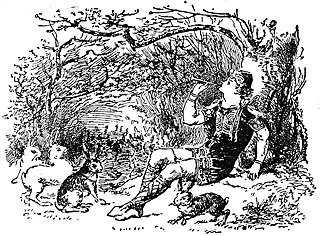 W
WJesper Who Herded the Hares is a Scandinavian fairy tale, first recorded by Danish folktale collector Evald Tang Kristensen in the first volume of Æventyr fra Jylland. Andrew Lang included it in The Violet Fairy Book.
 W
WJulebukking is a Christmas tradition of Scandinavian origin.
 W
WAccording to Swedish legend, the Knights of Ålleberg are ghosts of twelve knights who died in a 1389 battle. The legend is an example of the king asleep in mountain motif in folklore.
 W
WLifting stones are heavy natural stones which people are challenged to lift, proving their strength. They are common throughout northern Europe, particularly Scotland, Wales, Iceland, Scandinavia and North West England centred around Cumbria.
 W
WLindworms were popular motifs on runestones in 11th century Sweden. Portrayals vary across countries and the stories in which they appear, the creature generally appearing as wingless with a serpentine body, dragon's head, scaled skin and two clawed forelimbs. Depictions imply lindworms do not walk on their two limbs like a wyvern, but move like a mole lizard: they slither like a snake and use their arms for traction.
 W
WA mare is a malicious entity in Germanic and Slavic folklore that rides on people's chests while they sleep, bringing on nightmares.
 W
W"The Master Maid" is a Norwegian fairy tale collected by Peter Christen Asbjørnsen and Jørgen Moe in their Norske Folkeeventyr. "Master" indicates "superior, skilled." Jørgen Moe wrote the tale down from the storyteller Anne Godlid in Seljord on a short visit in the autumn of 1842. Andrew Lang translated the tale to English and included it in his The Blue Fairy Book (1889). A later translation was made by George Dasent, in his Popular Tales from the North.
 W
WThe Nixie, Nixy, Nix, Näcken, Nicor, Nokk, or Nokken are humanoid, and often shapeshifting water spirits in Germanic mythology and of folklore.
 W
WNorwegian Folktales is a collection of Norwegian folktales and legends by Peter Christen Asbjørnsen and Jørgen Moe. It is also known as Asbjørnsen and Moe, after the collectors.
 W
WThe Orkneyinga saga is a narrative of the history of the Orkney and Shetland islands and their relationship with other local polities, particularly Norway and Scotland. The saga has "no parallel in the social and literary record of Scotland" and is "the only medieval chronicle to have Orkney as the central place of action". The main focus of the work is the line of jarls who ruled the Earldom of Orkney, which constituted the Norðreyjar or Northern Isles of Orkney and Shetland and there are frequent references to both archipelagoes throughout.
 W
WThe Överhogdal tapestries are a group of extraordinarily well-preserved textiles dating from late Viking Age or early Middle Ages that were discovered in the village of Överhogdal in Härjedalen, Sweden.
 W
WPer Gynt is a Norwegian fairy tale which originated in the traditional region of Gudbrandsdal.
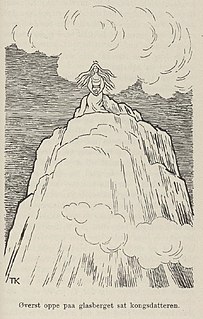 W
W"The Princess on the Glass Hill" or The Maiden on the Glass Mountain is a Norwegian fairy tale collected by Peter Christen Asbjørnsen and Jørgen Moe in Norske Folkeeventyr. It recounts how the youngest son of three obtains a magical horse and uses it to win the princess.
 W
WThe Prose Edda, also known as the Younger Edda, Snorri's Edda or, historically, simply as Edda, is an Old Norse textbook written in Iceland during the early 13th century. The work is often assumed to have been to some extent written, or at least compiled, by the Icelandic scholar, lawspeaker, and historian Snorri Sturluson c. 1220. It is considered the fullest and most detailed source for modern knowledge of Norse mythology, the body of myths of the North Germanic peoples, and draws from a wide variety of sources, including versions of poems that survive into today in a collection known as the Poetic Edda.
 W
WThe corpus of traditional riddles from the Finnic-speaking world is fairly unitary, though eastern Finnish-speaking regions show particular influence of Russian Orthodox Christianity and Slavonic riddle culture. The Finnish for 'riddle' is arvoitus, related to the verb arvata ('guess').
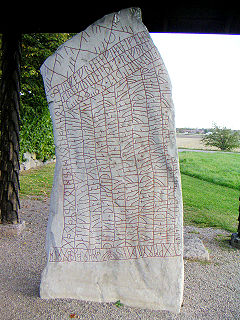 W
WThe Rök runestone is one of the most famous runestones, featuring the longest known runic inscription in stone. It can now be seen beside the church in Rök, Ödeshög Municipality, Östergötland, Sweden. It is considered the first piece of written Swedish literature and thus it marks the beginning of the history of Swedish literature.
 W
WA shield-maiden was a female warrior from Scandinavian folklore and mythology.
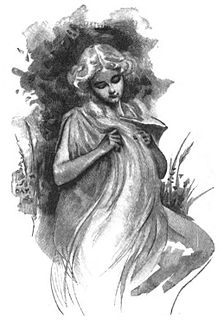 W
WIn Norse mythology, Sif is a golden-haired goddess associated with earth. Sif is attested in the Poetic Edda, compiled in the 13th century from earlier traditional sources, and the Prose Edda, written in the 13th century by Snorri Sturluson, and in the poetry of skalds. In both the Poetic Edda and the Prose Edda, she is known for her golden hair and is married to the thunder god Thor.
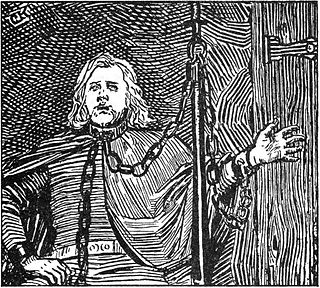 W
WA Skald, or skáld, is one of the often named poets who composed skaldic poetry, one of the two kinds of Old Norse poetry, the other being Eddic poetry, which is anonymous. Skaldic poems were traditionally composed on one occasion, sometimes extempore, and include both extended works and single verses (lausavísur). They are characteristically more ornate in form and diction than eddic poems, employing many kennings and heiti, more interlacing of sentence elements, and the complex dróttkvætt metre.
 W
WSnorri Sturluson was an Icelandic historian, poet, and politician. He was elected twice as lawspeaker to the Icelandic parliament, the Althing. He is commonly thought to have authored or compiled portions of the Prose Edda, which is a major source for what is today known as Norse mythology, and Heimskringla, a history of the Norwegian kings that begins with legendary material in Ynglinga saga and moves through to early medieval Scandinavian history. For stylistic and methodological reasons, Snorri is often taken to be the author of Egil's saga. He was assassinated in 1241 by men claiming to be agents of the King of Norway.
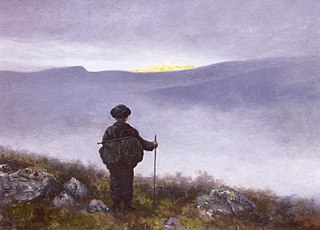 W
WSoria Moria Castle is a Norwegian fairy tale made famous by Peter Christen Asbjørnsen and Jørgen Moe in their classical Norske Folkeeventyr. Later Andrew Lang included the story in his series of fairy tale collections in The Red Fairy Book.
 W
W"Stolt Herr Alf" or "Álvur kongur" is a medieval Scandinavian ballad with Swedish and Faroese variants which, because of its content, is thought to originate from pre-Christian times. There are two different manuscripts of this ballad in the National Library of Sweden, and some dialectal words indicate that the ballad was current in south-western Sweden before its documentation.
 W
WSynty is an important concept in Finnish mythology. Syntysanat ('origin-words') or syntyloitsut ('origin-charms') provide an explanatory, mythical account of the origin of a phenomenon, material, or species, and were an important part of traditional Finno-Karelian culture, particularly in healing rituals. Although much in the Finnish traditional charms is paralleled elsewhere, 'the role of aetiological and cosmogonic myths' in Finnic tradition 'appears exceptional in Eurasia'. The major study remains that by Kaarle Krohn, published in 1917.
 W
W"Töres döttrar i Wänge" or "Per Tyrssons döttrar i Vänge" is a medieval Swedish ballad which Ingmar Bergman's The Virgin Spring is based on. The ballad type is found throughout Scandinavia, with variants in Danish, Faroese, Icelandic, and Norwegian. The Child Ballad "Babylon" is analogous to the Scandinavian songs.
 W
WA troll is a being in Scandinavian folklore, including Norse mythology. In Old Norse sources, beings described as trolls dwell in isolated rocks, mountains, or caves, live together in small family units, and are rarely helpful to human beings.
 W
WTrollkyrka is a secluded butte-like rock in the heart of the National Park of Tiveden, Sweden, which served as a pagan sacrificial ground for centuries after Christianity became the dominant religion in Scandinavia. It may have been used as late as the 19th century, when popular tradition still held the mountain to be off-limits for Christians.
 W
WThe Types of the Scandinavian Medieval Ballad: A Descriptive Catalogue (TSB) is the designation for a cataloguing system for Scandinavian ballads.
 W
WIn Norse mythology, a vargr is a wolf, especially the wolf Fenrir and the wolves that chase the sun and moon Sköll and Hati. Based on this, J. R. R. Tolkien in his fiction used the form warg, which may incorporate Old English wearh, as the name of a particularly large and evil kind of wolf that could be ridden by orcs. Through Tolkien's influence, the concept has been used in fantasy works by other authors and in other media.
 W
WWife selling is the practice of a husband selling his wife and may include the sale of a female by a party outside a marriage. Wife selling has had numerous purposes throughout the practice's history; and the term "wife sale" is not defined in all sources relating to the topic.
 W
WA wight is a creature or living sentient being. In its original usage, the word wight described a living human being, but has also come to be used within fantasy to describe certain immortal beings. The earliest example of this usage in English is in William Morris's translation of the Grettis Saga, wherein haugbui is translated as "barrow-wight". Wights also feature in J. R. R. Tolkien's world of Middle-earth, especially in The Lord of the Rings, and in George R. R. Martin's HBO television series Game of Thrones and novel series A Song of Ice and Fire. Since its 1974 inclusion in the RPG Dungeons & Dragons (D&D), it has become a recurring form of undead in other fantasy games and mods, such as Vampire: The Masquerade.
 W
W"The Witch in the Stone Boat" is an Icelandic folktale, originally collected by Jón Árnason (1864), translated into English in Andrew Lang's fairy tale collection The Yellow Fairy Book (1894).
 W
WThe Yule goat is a Scandinavian and Northern European Yule and Christmas symbol and tradition. Its origin may be Germanic pagan and has existed in many variants during Scandinavian history. Modern representations of the Yule goat are typically made of straw.